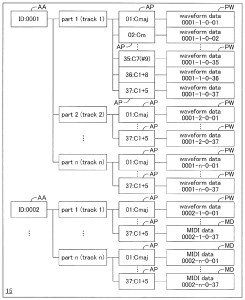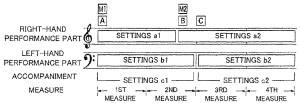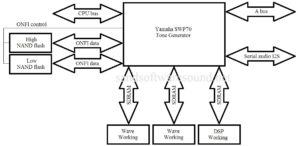Last year ’bout this time, we were all holding our collective breath awaiting the new Yamaha Montage. There are two products which I expect to see from Yamaha sometime in the next one to two years:
- The successor to the mid-range MOXF synthesizer, and
- The successor to the top-of-the-line (TOTL) Tyros arranger workstation.
NAMM 2017 seems a little too soon for both products. In the case of the MOXF successor, Yamaha conducted marketing interviews during the summer of 2015. I would guess that MOXF sales are still pretty good and no new products from the usual suspects (Korg, Roland) are visible on the horizon. The Krome and FA could both use an update themselves. Not much market pressure here at the moment. (Korg’s NAMM 2017 announcements are, so far, a little underwhelming.)
Read my MOX retrospective and interview follow-up.
I suspect that the Tyros successor is somewhat closer to launch. Speculation has been heated ever since Yamaha filed for a US trademark on the word mark “GENOS”. The word mark was published for opposition on November 15, 2016. “Published for opposition” means that anyone who believes that they will be damaged by registration of the mark must file for opposition within 30 days of publication. If “GENOS” is indeed the name for the Tyros successor, then the 30 day period ending December 15, 2016 is cutting it very close to NAMM 2017. Even more ludicruous if Yamaha were to begin manufacturing products printed with that name for a NAMM 2017 launch. Imagine the scrap if opposition was successful!
For quite some time, I have been meaning to summarize the key U.S. patents that I believe to be GENOS-related. (Assuming that “GENOS” is the name!) I’ve procrastinated because the launch date is most likely fall 2017 at the earliest as previous Yamaha mid- and high-end arranger models are typically launched in the fall in anticipation of the holiday selling season.
A much larger barrier is the task of reading and gisting the patents. Patents are written in legalese and are much more difficult to read than the worst written scientific papers! One of the folks on the PSR Tutorial forum suggested making a list of the top five technologies for the new TOTL arranger. I generally hate the superficial nature of “list-icles,” but the suggestion is a good one. Nothing will get done as long as the barrier is big because I would much rather jam and play! I’m supposed to be retired.
The 2016 Yamaha annual report states that Yamaha want to make innovative products which are not easily copied by competitors. Patents — legally protected intellectual property — are essential to achieving this goal. Generally, a company only applies for a patent on technology in which they have a serious business interest due to the significant cost of obtaining and maintaining patent protection.
So, here are a few of Yamaha patented technologies which could appear in future products — perhaps GENOS, perhaps others.
SWP70 tone generator
This may seems like old news…
The next generation SWP70 tone generator first appeared in the mid-range Yamaha PSR-S970 arranger workstation. The SWP70 made its second appearance in the Yamaha Montage synthesizer. The S970 incorporates only one SWP70 and does not make full use of the chip. (At least three major interfaces are left unconnected.) In keeping with Yamaha’s TOTL design practice, the Montage employs two SWP70 integrated circuits: one each for AWM2 sample-playback and FM. A second sample cache interface on the AWM2 side is unconnected.
The Tyros successor likely will use two SWP70 tone generators, too. The number of available tone generation channels with two SWP70s will be massive (512 channels). Yamaha could opt for a single SWP70 and still outmatch the current generation Tyros 5. Like the Montage, there will be enough insert effect DSP processors to cover each style and user part, as many as two for every part.
It will be interesting to see (and hear) if the GENOS will make use of the second sample cache interface. A second cache would not only support more tone generation channels, but might be necessary for long, multi-measure musical phrases that are needed for full audio styles (discussed below).
The SWP70 flash memory interface follows the Open NAND FLASH interface (ONFI) standard, the same as solid state drives (SSD). ONFI memory devices can be stacked on a bi-directional tri-state bus, so potentially, the GENOS could support a large amount of internal waveform storage. This flash memory will contain the “expansion memory,” that is, physical memory reserved in flash memory for user waveforms. The expansion flash memory expansion modules (FL512M, FL1024M) are dead, Jim.
If you’re interested in Yamaha AWM2 tone generation, here’s a few patents to get you started:
- Patent 9,040,800 Musical tone signal generating apparatus, May 26, 2015
- Patent 8,383,924 Musical tone signal generating apparatus, February 26, 2013
- Patent 8,389,844 Tone generation apparatus, March 5, 2013
- Patent 8,957,295 Sound generation apparatus, February 17, 2015
- Patent 8,035,021 Tone generation apparatus, October 2011
- Patent 7,692,087 Compressed data structure and apparatus and method related thereto, April 6, 2010
U.S. Patent 8,957,295 is the patent issued for the SWP70 memory interface. U.S. Patent 9,040,800 describes a tone generator with 256 channels — very likely the SWP70.
Pure Analog Circuit
This may seem like old news, too, since Pure Analog Circuit (PAC) debuted in the Yamaha Montage.
Pure Analog Circuit is probably the least understood and least appreciated feature of the Montage. It’s not just better DACs, people. The high speed digital world is very noisy as far as analog audio is concerned. Yamaha separated the analog and digital worlds by putting the DACs and analog electronics on their own printed circuit board away from noisy digital circuits. Yamaha then applied old school engineering to the post-DAC analog circuitry, paying careful attention to old school concerns like board layout for noise minimization and clean power with separate voltage regulation for analog audio. Yamaha’s mid- to high-end products have always been quiet — PAC is pristine.
Since the PAC board is a separate, reusable entity, I could see Yamaha adopting the same board for GENOS.
Styles combining audio and MIDI
Yamaha are constantly in search of greater sonic realism. Existing technologies like Megavoices and Super Articulation 2 (Advanced Element Modeling) reproduce certain musical articulations. However, nothing can really match the real thing, that is, a live instrument played by an experienced professional musician. PG Music Band-in-a-Box (BIAB), for example, uses audio tracks recorded by studio musicians to produce realistic sounding backing tracks. The Digitech TRIO pedal draws on the PG Music technology for its tracks. (“Hello” to the Vancouver BC music technology syndicate.)
Yamaha have applied for and been granted several patents on generating accompaniment using synchronized audio and MIDI tracks. Here is a short list of U.S. patents:
- Patent 9,147,388 Automatic performance technique using audio waveform data, September 29, 2015
- Patent 9,040,802 Accompaniment data generating apparatus, May 26, 2015
- Patent 8,791,350 Accompaniment data generating apparatus, July 29, 2014
- Application 13/982,476 Accompaniment data generating apparatus, March 12, 2012
There are additional patents and applications. Each patent covers a different aspect of the same basic approach, making different claims (not unusal in patent-land). Yamaha have clearly invested in this area and are staking a claim.
The patents cite four main motivations, quoting:
- The ability to produce “actual musical instrument performance, human voices, natural sounds”
- To play “automatic accompaniment in which musical tones of an ethnic musical instrument or a musical instrument using a peculiar scale”
- To exhibit the “realism of human live performance”
- To advance beyond known techniques that “provide automatic performance only of accompaniment phrases of monophony”
Your average guy or gal might say, “Give me something that sounds as natural as Band-in-a-Box.” Yamaha sell into all major world markets, so the ability to play ethnic instruments with proper articulation is an important capability. Human voice, to this point, is limited to looped and one-shot syllables, e.g., jazz scat. The new approach would allow long phrases with natural intonation. [Click on images in this article for higher resolution.]

Currently, mid- and high-end Yamaha arrangers have “audio styles” where only the rhythm track is audio. The patents cover accompaniment using melodic instruments in addition to rhythm instruments. The melodic audio tracks follow chord and tempo changes just like the current MIDI-based styles. Much of the technical complexity is due to synchronization between audio and MIDI events. Synchronization is troublesome when the audio tracks contain a live performance with rubato. Without good synchronization, the resulting accompaniment doesn’t feel right and sounds sloppy.
Accompaniment from chord chart
This next feature will be very handy. U.S. Patent 9,142,203 is titled “Music data generation based on text-format chord chart,” September 22, 2015. If you use textual chord charts (lyrics plus embedded chord symbols), you will want this!

Simply put, the technique described in this patent translates a textual chord chord to an accompaniment. The accompaniment is played back by the arranger. The user can select tempo, style, sections (MAIN, FILL IN) and so forth.
The translator/generator could be embedded in an arranger or it could be implemented by a PC- or tablet-based application. Stay tuned!
Selectively delayed registration changes
A registration is a group of performance parameters such as the right hand voice settings, left hand voice settings, accompaniment settings, and so forth. Mid- and high-end arrangers have eight front panel buttons where each button establishes a set of parameter values (“readout”) when the button is pushed. It’s the player’s job to hit the appropriate button at the appropriate time during a live performance to make voice settings, etc. A player may need a large number of buttons, if a musical performance is complicated.
Usually only a few parameters are different from one registration to the next. Recognizing this, the technique described by U.S. Patent 9,111,514 (“Delayed registration data readout in electronic music apparatus,” August 18, 2015) delays one or more parameter changes when a button is pushed. The user specifies the parameters to be delayed and the delay (such as the passage of some number of beats or measures, etc.) Thus, a single registration can cover the work of multiple individual registrations.

I’ll have to wait to see the final product to assess the usefulness of this feature. Personally, I’d be happy with a configuration bit to keep OTS buttons from automatically turning on the accompaniment (ACCOMP). Sure would make it easier to use the OTS buttons for voice changes.
Ensembles / divisi
Tyros 5 ensemble voices assign played notes to individual instrument voices in real time, allowing a musician to perform divisi (divided) parts. Tyros 5 ensembles can be tweaked using its “Ensemble Voice Key Assign Type List.” Types include open, closed, and incremental voice assignment. U.S. Patent 9,384,717, titled “Tone generation assigning apparatus and method” and published July 5, 2016, extends Tyros 5 ensemble voice assignment.
The technique described in 9,384,717 gives the musician more control over part assignment through rules: target depressed key, priority rule, number of tones to generated, note range, etc. The rules handle common cases like splitting a single note to two or more voices.

These extensions could lead to some serious fun! I didn’t feel like the Tyros 5 ensemble feature was sufficiently smart and placed too many demands on the average player, i.e., less-than-talented me. The rules offer the opportunity to shift the mental finger work to software and perhaps could lead to more intuitive ensemble play. Neat.
Voice synthesis
As I alluded to earlier, arrangers make relatively primitive use of the human voice. Waveforms are usually limited to sustained (looped) or short (one-shot) syllables.
Yamaha have invested a substantial amount of money into the VOCALOID technology. VOCALOID draws on a singer database of syllable waveforms and performs some very heavy computation to “stitch” the individual waveforms together. The stitching is like a higher quality, non-real time version of Articulated Element Modeling (AEM).
VOCALOID was developed through a joint research project (led by Kenmochi Hideki) between Yamaha and the Music Technology Group (MTG) of the Universitat Pompeu Fabra in Barcelona, Spain. VOCALOID grew from early work by J. Bonada and X. Serra. (See “Synthesis of the Singing Voice by Performance Sampling and Spectral Models.”) More recent research has stretched synthesis from the human voice to musical instruments. Yamaha hold many, many patents on the VOCALOID technology.
Patent 9,355,634, titled “Voice synthesis device, voice synthesis method,” is a recent patent concerning voice synthesis (May 31, 2016). It, too, draws from a database of prerecorded syllables. The human interface is based on the notion of a “retake,” such as a producer might ask a singer to make in a recording studio using directives like “put more emphasis on the first syllable.” The retake concept eliminates a lot of the “wonky-ness” of the VOCALOID human interface. (If you’ve tried VOCALOID, you know what I mean!) The synthesis system sings lyrics based on directions from you — the producer.
An interface like this would make voice synthesis easier to use, possibly by novices or non-technically oriented musicians. The big question in my mind is whether voice synthesis and editing can be sped up and made real time. Still, wouldn’t it be cool if you could teach your arranger workstation to sing?
Music minus one
This work was conducted jointly with the MTG at the Universitat Pompeu Fabra. A few of the investigators were also involved in VOCALOID. Quoting, “The goal of the project was to develop practical methods to produce minus-one mixes of commercially available western popular music signals. Minus-one mixes are versions of music signals where all instruments except the targeted one are present.”
This is not good old center cancellation. The goal is to remove any individual instrument from a mix regardless of placement in the stereo field. You can hear a demo at http://d-kitamura.sakura.ne.jp/en/demo_deformation_en.htm.
I doubt if this technique will appear on an arranger; the computational requirements are too high and the method is not real time. However, “music minus-one” is very appealing to your average player (that is, me). My practice regimen includes playing with backing tracks. I would love to be able to play with any commercial tune on whim.
There are patents:
- US Patent 9,002,035 Graphical audio signal control
- US Patent 9,224,406 Technique for estimating particular audio component
- US Patent 9,070,370 Technique for suppressing particular audio component
and there are scientific papers:
- “Audio Source Separation for Music in Low-latency and High-latency Scenarios”, Ricard Marxer Pinon, Doctoral dissertation, Universitat Pompeu Fabra, Barcelona, 2013.
- D. Kitamura, et al., “Music signal separation by supervised nonnegative
matrix factorization with basis deformation,” Proc. DSP 2013, T3P(C)-1, 2013.
- D. Kitamura, et al., “Robust Music Signal Separation Based on Supervised Nonnegative Matrix Factorization with Prevention of Basis Sharing”, ISSPIT, December 2013.
Music analysis
Yamaha have put considerable resources into what I would call “music analysis.” These technologies may not (probably will not) make it into an arranger keyboard. They are better suited for PC- or tablet-based applications.
I think we have seen the fruits of some of this labor in the Yamaha Chord Tracker iPad/iPhone application. Chord Tracker identifies tempo, beats, musical sections and chords within an audio song from your music library. It displays the extracted info in a simple chord chart and can even send the extracted “lead sheet” to your arranger. The arranger plays back the “lead sheet” as an accompaniment using the selected style.
We’re probably both wondering if Chord Tracker will integrate with the chord chart tool described above. Stay tuned.
Yamaha Patent 9,378,719 (June 28, 2016) is a “Technique for analyzing rhythm structure of music audio data.” Patent 9,117,432 (August 25, 2015) is an “Apparatus and method for detecting chords.” I wouldn’t be surprised if Chord Tracker draws from these two patents.
Yamaha has also investigated similarity measures and synchronized score display:
- Patent 9,053,696 Searching for a tone data set based on a degree of similarity to a rhythm pattern, June 9, 2015
- Patent 9,006,551 Musical performance-related information output device, April 14, 2015
- Patent 9,275,616 Associating musical score image data and logical musical score data, March 1, 2016
I’m not sure where Yamaha is going with similarity measures and searching. Will they use similarity measures to selected accompaniment phrases? Who knows?
The work on score display synchronizes the display of the appropriate part of a musical score with its live or recorded performance. These techniques may be more appropriate to musical education and training, particularly for traditional brass, string and woodwind players. Yamaha derives considerable revenue from traditional instruments and this is perhaps a way to enhance their “ecosystem” for traditional acoustic instruments.
Score display is one possible application of Yamaha’s patented technique to transmit performance data via near-ultrasonic sound. The technique borrows one or more tone generation channels to generate the near-ultrasonic data signal. See my earlier post about U.S. Patent 8,779,267 for more details.
So long for now!
That’s it! I hope you enjoyed this brief tour through a few of Yamaha’s recent patent grants and filings.
If you want more information about a particular patent, then cruise on over the the U.S. Patent and Trademark Office (USPTO) web site. Navigate to patent search and plug in the patent number.
Copyright © 2017 Paul J. Drongowski






